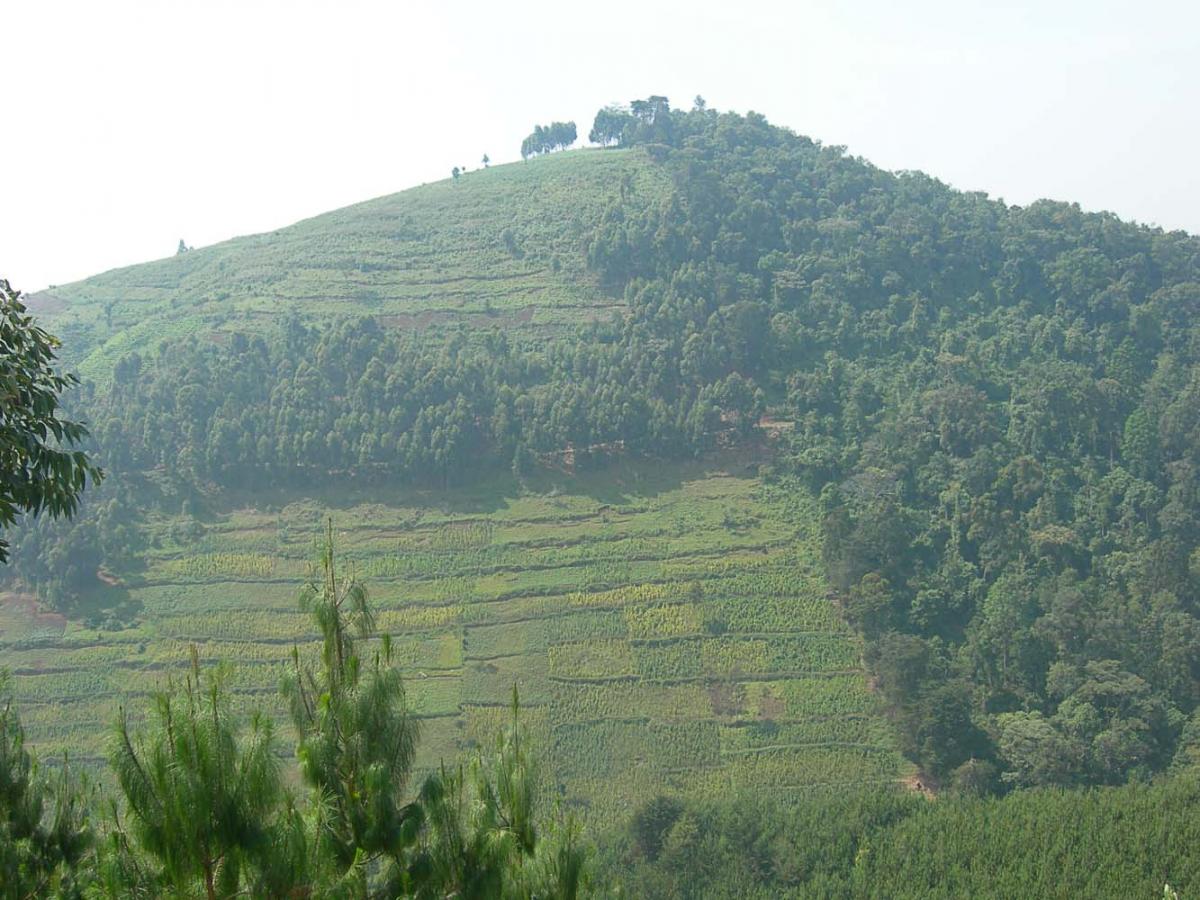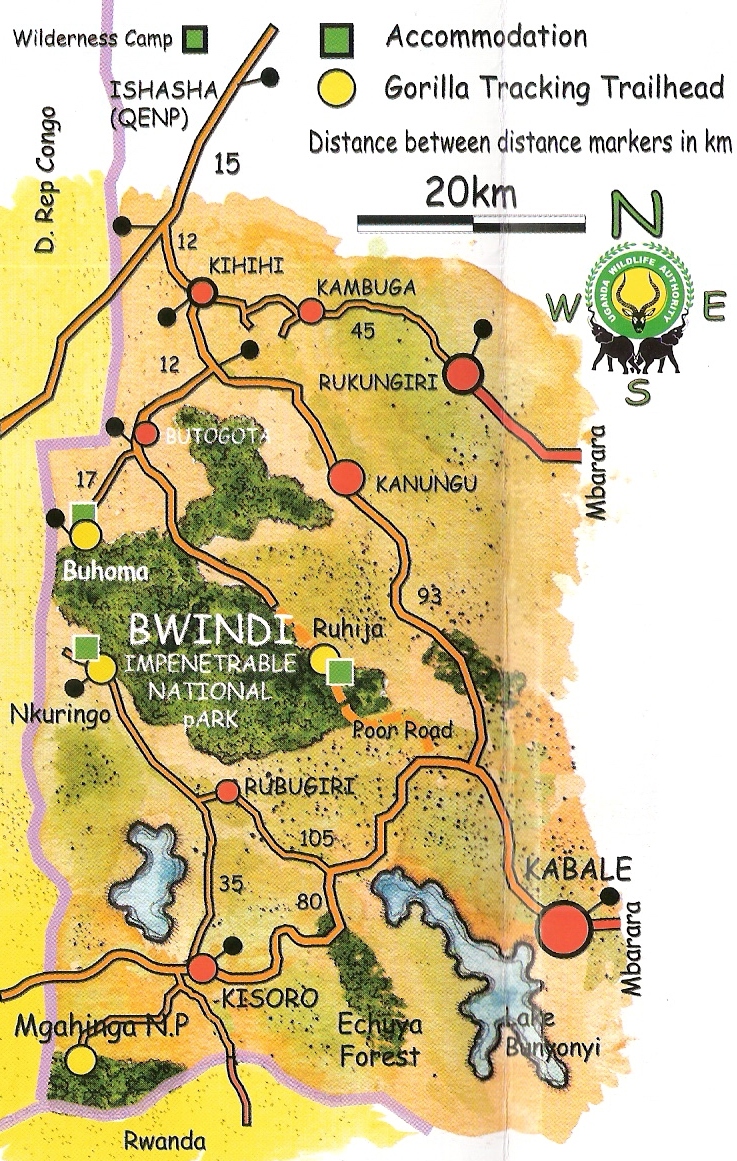 Bwindi Impenetrable National Park is located in southwestern Uganda in East Africa. The park is part of the Bwindi Impenetrable Forest, and is situated along the Democratic Republic of Congo border next to the Virunga National Park and on the edge of the western Great Rift Valley. It comprises 331 square kilometers (128 sq mi) of jungle forests and contains both montane and lowland forest and is accessible only on foot. Bwindi was gazetted as a national park in 1991 and declared a Natural World Heritage Site by UNESCO in December 1994.
Bwindi Impenetrable National Park is located in southwestern Uganda in East Africa. The park is part of the Bwindi Impenetrable Forest, and is situated along the Democratic Republic of Congo border next to the Virunga National Park and on the edge of the western Great Rift Valley. It comprises 331 square kilometers (128 sq mi) of jungle forests and contains both montane and lowland forest and is accessible only on foot. Bwindi was gazetted as a national park in 1991 and declared a Natural World Heritage Site by UNESCO in December 1994.
The forest is one of the richest ecosystems in Africa, and the diversity of species is a feature of the park. The park provides habitat for some 120 species of mammals, 348 species of birds,  220 species of butterflies, 27 species of frogs, chameleons, geckos and many endangered species. Floristically Bwindi is amongst the most diverse forests in East Africa, with more than 1,000 flowering plant species including 163 species of trees and 104 species of ferns. The northern (low altitude) sector is rich in species of the Guineo-Congolian flora. These include two species internationally recognized as endangered, Brown mahogany (Lovoa swynnertonii) and Brazzeia longipedicellata. In particular the area shares in the high levels of endemisms of the Albertine Rift.
220 species of butterflies, 27 species of frogs, chameleons, geckos and many endangered species. Floristically Bwindi is amongst the most diverse forests in East Africa, with more than 1,000 flowering plant species including 163 species of trees and 104 species of ferns. The northern (low altitude) sector is rich in species of the Guineo-Congolian flora. These include two species internationally recognized as endangered, Brown mahogany (Lovoa swynnertonii) and Brazzeia longipedicellata. In particular the area shares in the high levels of endemisms of the Albertine Rift.
The park is a sanctuary for colobus monkeys, chimpanzees and many birds (such as hornbills and turacos). Bwindi impenetrable is perhaps most notable for the 480 mountain gorillas, half of the world's population of the critically endangered Mountain Gorillas as per 2010 census carried out in this Park.
Bwindi National Park’s history began years back in 1932, where two blocks of the Bwindi Impenetrable Forest were marked as Crown Forest Reserves. The Northern block was marked as the "Kayonza Crown Forest Reserve," and the Southern block marked as the "Kasatora Crown Forest Reserve. In 1942, the two Crown Forest Reserves were combined and enlarged and renamed the Impenetrable Central Crown Forest with a total area of 298 square kilometers (115 sq mi). In 1964, the reserve was declared as an animal sanctuary in order to provide extra protection to its mountain gorillas and renamed the Impenetrable Central Forest Reserve. Later on in 1966, two other forest reserves became part of the main reserve which increased its area to 321 square kilometers (124 sq mi).
In 1991, the Impenetrable Central Forest Reserve, Mgahinga Gorilla Reserve and the Rwenzori Mountains Reserve were designated as national parks. It was renamed Bwindi Impenetrable National Park in the same year to protect a range of species within it and specifically the mountain gorilla.
The reclassification of the park has a large impact on the Batwa pygmy people, who were evicted from the forest and are no longer permitted to access the resources of the forest or the park. Gorilla tracking became a tourist activity in April 1993, and thus the park became a popular tourist destination in the country. In 1994, the park’s management changed and was under Uganda National Parks which was renamed Uganda Wildlife Authority. In 2003, the park was enlarged by purchasing a piece of land next to the park with an area of 4.2 square kilometres (1.6 sq mi) and later incorporated into the park.
In March 1999, a rebel force of about 100-150 former Rwandan Interahamwe infiltrated across the border from the Democratic Republic of the Congo and kidnapped 14 foreign tourists and one Ugandan guide from Buhoma the park headquarters. They released six 6 and murdered the remaining eight. This attack was intended to "destabilize Uganda" and frighten away tourist traffic from Bwindi hence depriving vital income to the Ugandan government. Bwindi was closed for several months and the popularity of Uganda gorilla tours were affected for several years. However, the Park has regained its name due to area stability and ranger guides with rifles who accompanies each and every tourist visiting the park to see the Gorillas.
Gorilla Population Census in Bwindi has been so far carried out five times and the first census of 1997 revealed 300 gorillas while the number increased to 320 in 2002. However due to increase in poaching on death of Mountain Gorillas, the number has decreased to 302 according to the 2006 census.
Gorilla tracking is the park's main tourist attraction and tourists wishing to track the endangered Mountain gorillas must first obtain a permit to do so. Gorilla tracking is highest activity that generates revenue for Uganda Wildlife Authority. There are strict rules put forward for tourists follow so as to minimize the risk of passing diseases to the gorillas. Tourists can visit the park any time throughout the year, although conditions in the park and the roads leading to the Park are more difficult during the rainy season.
The park is also a home to more than 348 species of birds, 220 species of butterflies, 27 species of frogs, chameleons, geckos and many endangered species. Birding in the Ruhija sector from the Ruhija trekking point with special guides is also another famously known activity which the Park offers. There is also Forest walks like the Munyaga water fall walk that is available from Buhoma and the trek can take up to 3 hours.
The Nkuringo sector of the park also offers a lot of activities other than Gorilla trekking such as cycling and the walking safaris. The walking trail starts from Nkuringo to Buhoma along the forest and can take up to 6 hours.


